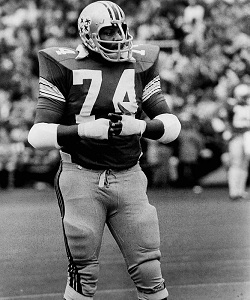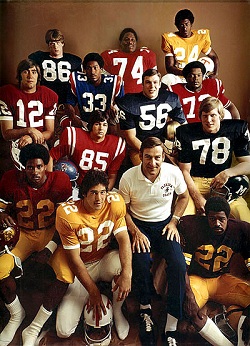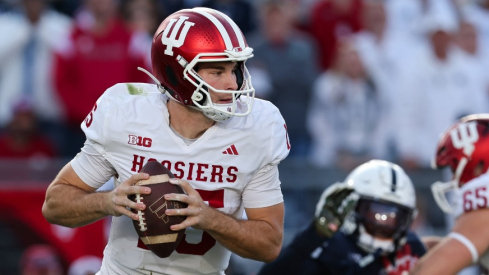 John Hicks loved to taunt defensive players.
John Hicks loved to taunt defensive players.The guys who play on the offensive line do not often bask in the football spotlight at the college level, or any other level for that matter. They work hard to clear space for the glory boys who carry the ball, and they fight off mauling defensive linemen and ferocious blitzers in order to protect the offense's most valuable asset: the quarterback.
Most fans couldn't tell you from one year to the next who the guys on the line are, but there was a year in the early 70's when one particular lineman displayed such excellence that almost everyone in the country knew who he was. He was the cornerstone of a running attack that dominated the Big Ten and rolled over USC in the Rose Bowl.
John Hicks was one of the finest offensive linemen ever to play at Ohio State. He was an All-Big Ten and 1st team All-American his last two seasons. In his senior year of 1973, Ohio State rushed for an astounding 3618 yards and sophomore tailback Archie Griffin was named Big Ten MVP. Hicks won the Outland Trophy and the Lombardi Award, and finished 2nd in the Heisman Trophy voting (the last offensive lineman to finish that high).
In his first year of eligibility, Hicks immediately earned a spot on the starting offensive line. He would start for 3 seasons over 4 years (a knee injury cost him the 1971 season) and the Buckeyes during that time played in 3 Rose Bowls and went undefeated against Michigan. No player has ever made it easier for Woody Hayes to run his smash-mouth offense.
Rushing yardage is one way to measure the impact of the offensive line, but perhaps wins are the best barometer. During John Hicks' three years as a starter, OSU went 28-3-1 and won at least a share of the Big Ten title each year. His first year (1970) was the final season for the "super sophomores" who had won the national title in 1968. They went undefeated again during the 1970 regular season, but lost to Stanford in the Rose Bowl.
The 1972 season heralded the entrance of a new star in the Ohio State football firmament. Freshman tailback Archie Griffin rushed for 772 yards on 139 carries to give Buckeye fans a taste of what they would see for the next three years. Hicks led the offensive line in his first season back from injury, and they finished the season 9-2 after dropping a 42-17 Rose Bowl contest against USC. The loss stung, but Hicks and the Buckeyes would get another chance the next season and make the most of it.
Ohio State's 1973 team may have been their best ever. During the regular season, their defense led the nation in scoring defense, giving up an average of only 4.3 points per game. But the offense was even better, scoring 413 points on the season and averaging 37.5 points per game (third highest in school history). What is most impressive about those totals and the aforementioned rushing yardage total was that everyone in the stadium knew what they were going to do. OSU threw only 76 passes on the season, and they rarely needed to pass because no one could stop the running game.
After disposing of Minnesota and TCU in dominating fashion to start the season, Ohio State moved into the #1 position in the rankings, and they would stay there until the season finale. But the domination of the offensive line was demonstrated most effectively after starting fullback Champ Henson was lost for the season with an knee injury. Coach Hayes moved linebacker Bruce Elia to fullback and the running game never missed a beat. In a 24-0 victory over Wisconsin in game 4, Griffin rushed for 169 yards, Elia gained 74, and sophomore QB Cornelius Greene (later changed to "Green") ran for 81 yards of his own.
The next game against Indiana, Griffin would rush for 130 yards and Elia for 123 in a 37-7 thrashing of the Hoosiers. In game 9 against Iowa, Griffin set a new school record by rushing for 246 yards on 30 carries. Overall for the season, Griffin rushed for 1577 yards on 247 carries for a 6.4 yard average. The yardage total set a new season record at the time and it's still the 5th highest in school history.
 Hicks as part of Playboy's 1973 All-American team.
Hicks as part of Playboy's 1973 All-American team.The rushing attack was mostly held in check in the season finale against Michigan, and as a result OSU settled for a 10-10 tie. Since the two schools had tied for the Big Ten championship, the conference's athletic directors got together to have a vote on which school should represent them in the Rose Bowl. Perhaps influenced by the injury to Michigan QB Dennis Franklin, the AD's voted to send Ohio State, and they did not regret it.
The Buckeyes trailed USC 21-14 until the 3rd quarter, where they started rolling and didn't stop until they had scored 28 unanswered points to close out a 42-21 victory. The team rushed for 320 yards behind the blocking of Hicks, Elia, and massive freshman fullback Pete Johnson. It was a fitting end to Hicks' career at OSU, but merely a prologue to the careers of Griffin, Greene, and Johnson. Ohio State finished the season with a record of 10-0-1, but had to settle for a #2 ranking when Notre Dame defeated Alabama to capture the national championship.
After the season, Hicks cleaned up on post-season awards. He claimed the Outland Trophy and the Lombardi Award, but fell just short in the race for the Heisman. 23 years later, another OSU offensive tackle, Orlando Pace, would nearly duplicate the feat, finishing 4th in the Heisman voting. All-Big Ten and All-American accolades followed, and a career in the NFL beckoned.
John Hicks was drafted 3rd overall in the draft by the New York Giants in 1974, and he played in New York for 3 seasons. After that, the Giants traded him to Pittsburgh, but injuries kept him from playing there and eventually ended his career. Hicks afterward moved back to Columbus and went into business. He still works in the area today, protecting financial assets for people the way he used to protect his quarterbacks. I'm sure his clients feel very safe.

